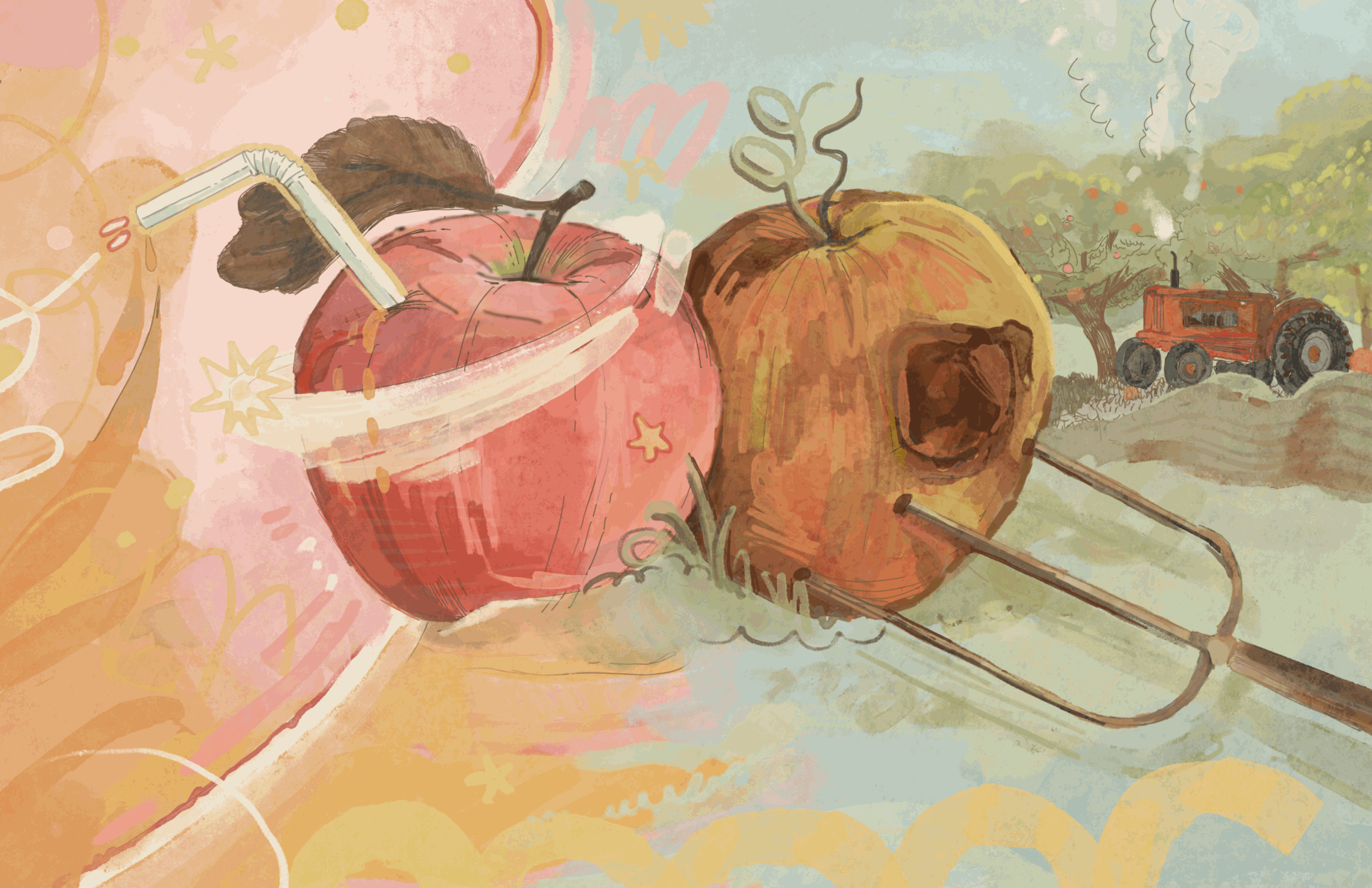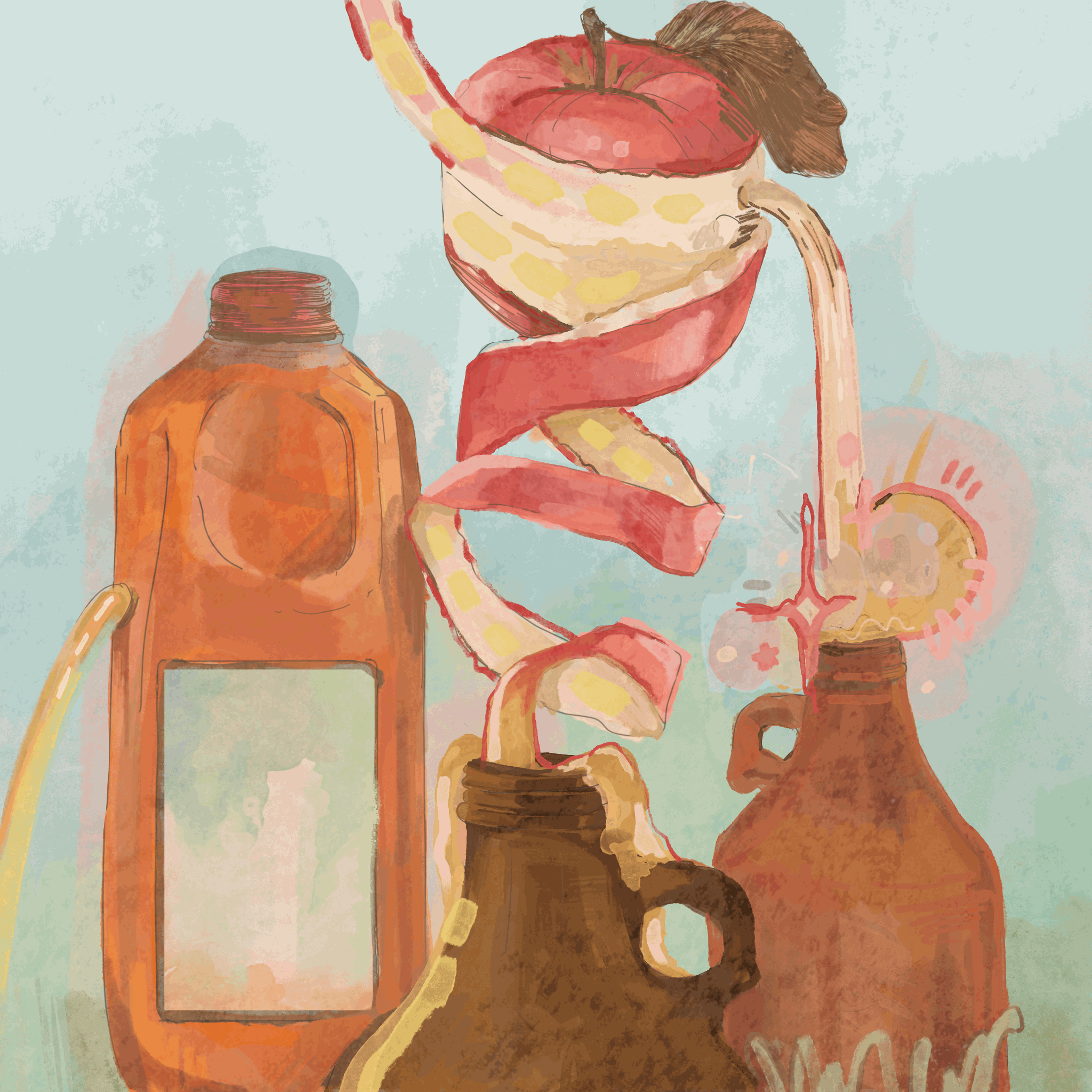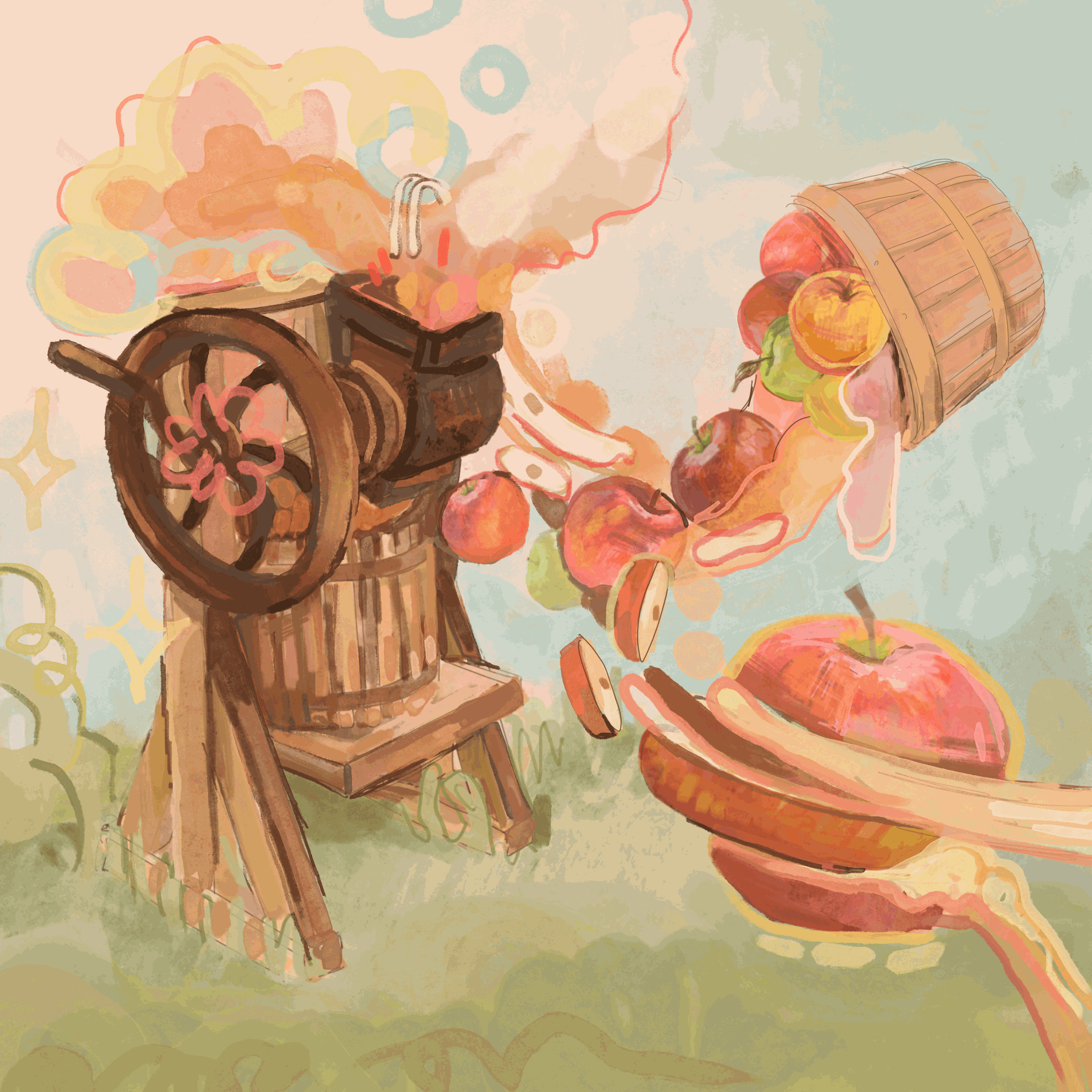Autumn Stoscheck started Eve’s Cidery in the Southern Tier of New York in 2001 on land her grandmother purchased in 1970. Buying the property had been a conscious escape from a hard life in New York City for the woman and her four children—one of them Autumn’s father—and represented not only financial freedom and a safer environment in which to raise her family, but a hopeful return to the remembered golden years of her own childhood.
“She was an immigrant and had a very difficult life,” says Stoscheck. “Her life’s goal was to get out of New York City and onto a farm, which was where some of her best memories were as a child in Germany.”
Despite living on a farm property, Stoscheck’s grandparents never did much farming; the property was something of a hippie commune in the ‘70s. It wasn’t until the 1990s that Stoscheck, then a young adult, looked at her ancestral home as a way to make a living. She mentored under her now-business-partner, James Cummins, a sixth-generation orchardist, before the pair founded the cidery at a significant point in the history of small-scale farming in America. After watching many of the dairy farms in the region collapse during the dairy crisis of the 1980s, Stoscheck came of age during the onset of the slow food movement of the 1990s. People were getting back to the land, and re-idealizing the family farm.
Starting a small family farm felt like a statement of purpose at the time, an expression of faith in the American ideal of working the land and making it prosper. Apple trees bending under the weight of ripe fruit paint an idyllic image of grace and grit, emblematic of the bootstrap doctrine so central to the country’s self-image. As with other areas of American life though, this nostalgic picture doesn’t always sync with the reality on the ground. Farms are businesses, and keeping them running in the face of industrialized agriculture, mounting costs, and fickle markets requires more than hard work and determination.
“There are some ideas and ideals that were baked into that time with sustainable local agriculture that sort of mythologized the American farm,” says Stoscheck. “I’ve watched a lot of them where their ideals around the family farm didn’t pan out. It’s not necessarily economically realistic.”
As with so many aspects of America’s golden portrait of itself, family farms have been swathed in poetic sentiment but largely left to sustain themselves on legend and luck. According to an extensive survey by the U.S. Department of Agriculture, the total number of U.S. farms dropped by nearly 142,000 from 2017-2022, a loss of nearly -7%, while the total number of farmed acres dropped by about -2%. Farmland is being consolidated by larger companies, and the story of what once made rural America’s economy so special is becoming more of a myth, now defined by corporate efficiencies and profits.
For some, this tale isn’t finished. Across the country, apple farms have turned to hard cider as a new kind of revenue stream, with the hope of removing luck from an equation that has taken away so many small farms—and with them, generations of memories of working the land.
At Draper Girls Farm in Parkdale, Oregon, about 80 miles east of Portland, Theresa Draper started making hard cider in the early 2010s at the prompting of her daughters, who were in college at the time. Her parents had started growing apples in 1962 after moving north from California, and Theresa helped them expand into a u-pick model in the 1980s. She and her now ex-husband took over the orchard from them in 2006.
While her parents sold apples in bulk to packing houses and at a roadside stand, Draper began pushing the agritourism side of the business after taking over, as a way to add extra income. Alongside apples, the farm has long produced a sweet, non-alcoholic cider from its fruit. She saw the addition of hard cider as a natural extension of the agritourism model, adding another revenue stream for the farm.
“As with so many aspects of America’s golden portrait of itself, family farms have been swathed in poetic sentiment but largely left to sustain themselves on legend and luck. ”
Draper Girls released its first hard cider in 2017, and initially tried to work with a wholesaler to distribute it, but Theresa realized she made a much better profit margin selling cider on her farm as a value-added product of the u-pick model. If her customers were already coming to her, why bother sending the cider out into the world via other channels?
The farm’s small-batch cider isn’t cheap—a 16oz growler is $15 to-go at the farm, versus the typical $10-$15 for a 72oz six-pack for many hard cider brands in retail stores—and distributors and on-premise accounts didn’t want to pay the prices she needed. “I feel like [a lot of cideries] sell it really inexpensive because they’re trying to compete with beer,” she says. “I feel like it should be more like wine. I have high prices, because I feel like that’s what it’s worth.”
Draper’s experience is indicative of a problem facing many orchards that have transitioned from culinary apples to cider varieties or cider itself: People don’t expect to pay a lot for apples or apple products, regardless of quality. Ironically, for a product now being looked at to boost farm income, history is not on cider’s side when it comes to premium pricing. When you can spend a couple bucks for multiple apples at a grocery store, the fruit’s long history as a workaday snack can prevent consumers from seeing Draper’s orchard-grown apples—and the cider made with them—as worthy of the extra spend.
“To be fair, what we have been trying to do with cider fruit as a higher-value farm crop is new in the industry,” says Kevin Zielinski of E.Z. Orchards in Salem, Oregon. “Up to the time of Prohibition and even after, cider was never made from a high-value product. Unlike a wine grape that’s grown just for making wine, cider was usually made from excess fruit or fruit that was going to waste.”
Zielinski’s family have been orchardists for about a century. He started growing cider varietals for other makers in 2000, and released the first vintage of his own line of hard cider in 2009. While he’s seen some movement in the perception of apples as a potential high-value crop, progress has been slow. As with cacao, coffee, and other commodity crops, public understanding of the value of cider has taken time to develop, and it’s still a work in progress. According to the American Cider Association, estate-grown ciders like the ones sold by Draper or Zielinski can range between $18-$40 a 750ml bottle, with the most common price between $24-$30. While there are cider lovers happy to splurge at those costs for a single bottle, most of the public won’t when hard cider is so readily found for much cheaper in stores all over.
Beyond getting a fair price for their products, orchards looking to produce their own cider or grow cider apples for another maker have another problem to face before they can even get started: Cider is generally made from dedicated cider apple varieties the farm probably isn’t already growing. There’s cost involved in planting and growing new trees—Stoscheck says it can cost $30,000-$40,000 per acre just to get started—and it takes several years before those trees will yield a crop. From starting the process to selling your cider might take five to 10 years. And that’s if you picked the right varietals for a craft cider market always seeking something new.
While cider has worked to separate itself from craft beer, one phenomenon frustrates producers in both segments: The styles that sell well today could be collecting dust tomorrow. In beer, this requires breweries to pay attention to consumer desires and be quick on their feet to meet demand. In cider, it requires a crystal ball and a lot of hope.
“There are apple varieties that 20 years ago were the hottest new kids on the block, but now are kind of lost in the marketplace,” Zielinski says of a phenomenon that brings to mind the treadmill of popularity in hop varieties for IPA. Veterans of the industry, like Zielinski, have stopped chasing hype varieties and focus on agronomy, resiliency, and just making really good cider.
This can in turn help smooth out peaks and troughs on the culinary apple side of the business as well. Kari Williams founded Snow Capped Cider in Cedaredge, Colorado, in 2014 as a separate but symbiotic business to her family farm, which has operated since 1912. The Williams family orchard is the largest in Colorado and, at just over 6,000 feet, the highest in elevation in the Northern Hemisphere. Williams now also owns her own small, cider-dedicated orchard, and while she does produce some single-variety ciders, she also buys a lot of apples from the family orchard for her culinary cider blends—largely apples that, for one reason or another, don’t find a buyer otherwise.
In these cases, the sorting facility at the orchard mechanically separates out apples that wouldn’t work for grocery and sends them directly to a bin earmarked for Snow Capped.
“Let’s say Kroger changes their mind and they don't want particular sizes anymore,” she says, explaining the difficulty of growing apples to meet very specific grocery demands. “So if [the farm] loses that sale, every bit of that comes off of the packing lines and gets dumped into my juice bins. Years fluctuate; the market shifts constantly.”
In one instance, Williams says her farm had prepared loads of Evercrisp apples for grocery sales, but the demand wasn’t there. With a surplus of that variety, it all went into her culinary cider blends. “It takes care of a lot of problems for us at the end of a weird year for fruit sales,” she adds.
“Our ability to take all the waste fruit is great,” Williams says. “There’s no hauling it, no expense to it. It gets used and that’s a huge benefit to us. They don’t have to sell it to someone else for half the price.”
Snow Capped Cider and the Williams family orchards take pride in producing as little waste as possible—the cidery also delivers waste to neighboring farms to feed to pigs and other livestock—so while this purchasing arrangement represents a relatively small revenue stream for the farm, it aligns with the core values for both businesses.
Despite the boost it has provided for many family orchards, cider still generally represents a modest percentage of the overall business for most small farms that have chosen this path. At Draper Girls, Theresa estimates about 25% of her revenue comes from cider. At E.Z., Zielinski says about 20% of gross revenue is from cider fruit—including fruit he sells to other makers—while his cider itself is an even smaller part of his trade.
For Zielinski and other growers, there is a symbiotic silver lining at play, though: Hard cider can serve as a marketing tool for the quality of their cider fruit, boosting sales for that segment of the business. “In the earlier days of our entry into the cider trade … it gave us an opportunity to be seen, which actually led to a great opportunity for us to grow the fruit and sell it to other cider makers,” he says.
“Despite the boost it has provided for many family orchards, cider still generally represents a modest percentage of the overall business for most small farms that have chosen this path.”
At Snow Capped, the cider has also led to culinary apple sales. The family owns a small farm in Texas in addition to their main Colorado property, and sells to groceries and school systems there, but Snow Capped Cider is not currently distributed in the state. When accounts there began calling on her for cider, Williams was able to pass them along to her husband as fruit buyers.
“My interest really with Snow Capped Cider is to represent the family on the very best level for what we've done for over a hundred years,” she says, then pauses before continuing. “And obviously to make the very highest quality cider I can consistently.”
The problems with the modern legend of the American family farm extend beyond a potentially unsustainable economic future—they also often reflect a misguided vision of the past.
Ask many folks who grew up in the American education system about the first person who comes to mind when they think of apples in our country’s history, and you’ll likely hear about Johnny Appleseed, the whimsical name of a very real orchardist who introduced apple trees to much of the Midwest. Despite the good work Appleseed accomplished (he was an early and important conservationist), his mythos overshadows the names we never learned: the enslaved people responsible for making cider on early American plantations, and the Black people who were never able to buy into generational land ownership in the first place at a time when it was still affordable to do so.
“There’s a lot of weird mythology baked into farming here,” says Stoscheck. “There’s this Jeffersonian ideal and lots of warped and twisted stuff around white people and their relationship to land.”
The mention of Thomas Jefferson is apt. He’s often cited in association with cider because of his love for the drink (as well as for beer and wine), which was made on his Monticello estate in Virginia. What isn’t mentioned as often is that the cider he so prized was made by men and women he enslaved. Accounts show that George and Ursula Granger were likely accountable for making cider on the plantation, as well as a Black man named Jupiter Evans, though their names have rarely been mentioned in history books.
While some cider makers are working to credit these individuals so long excluded from the beverage’s fanciful histories, no amount of attention can change the economic and land-ownership patterns set into motion in centuries past that have made Black-owned farms a rarity still today. While there are a handful of Black-owned cideries in the U.S.—D.O.P.E. Cider House & Winery in Youngstown, Ohio, and Momentum Ciders in San Francisco, California, are good examples—there are currently no active Black-owned farms producing their own hard cider, despite nearly half of American cideries growing at least some of their own apples.
Leandra King at Detroit Farm & Cider was briefly the first, using an urban farm in the Motor City where she’s grown 139 fully mature apple trees on just under three acres of land. But that dream is on hold amidst an ongoing legal battle to have farm animals on the land within city limits. It was the stark contrast of not seeking any other Black farmers doubling as cider makers that made her excited to launch her business despite no background or certification in farming.
“I just saw a platform for it,” she explains. “I started doing some digging. Most cider mills are generational.”
Michelle McGrath, CEO of the American Cider Association, is actively searching for ways to get more BIPOC individuals into the cider segment, as landowners and in production. She thinks another beverage-alcohol segment might offer a pattern to follow: “In California wine country there are more BIPOC-owned wineries developing, often as a vineyard-worker-to-winery-owner story,” explains McGrath. “So how can that happen in the cider industry?”
“There’s a lot of weird mythology baked into farming here. There’s this Jeffersonian ideal and lots of warped and twisted stuff around white people and their relationship to land.”
Most family-owned farms have been owned by their respective families for a long, long time, representing part of the generational wealth that has perpetuated wealth disparity between different ethnic communities in the U.S. When much of the country’s tillable land was being parceled out and sold, few Black families had the means to purchase. Now, the landscape has changed for the worse: Buying in is rarely, if ever, an option. “If somebody has real interest in farming fruit for cider production, it takes an incredible amount of capital,” explains Zielinski at EZ. “We’re past the days when land is available. Land is expensive now or it’s not available at all.”
Given the expense of purchasing farmland, King sees rejuvenating cities as possible opportunities for other Black farmers to start operations. Detroit saw a tremendous amount of suburban flight in the late 20th century, leading to numerous vacant properties throughout the city center. Now that the city is being redeveloped, there’s an opportunity to buy arable land—something that is no longer much of a possibility in rural agricultural areas.
Stoscheck says we need to get creative with how we reimagine the future of farming and land ownership in the U.S. if we’re to right the country’s past wrongs, and pave the way for a more sustainable future. “When we’re just linking the next generation to these land assets that go from family to family, we’re really limiting what that can look like,” she reflects. “How can we be more inclusive and start taking down barriers to being involved in farming and reach people who have been marginalized from farming or owning farms?”
One small step she sees possible movement toward is the pooling of resources—operating as co-ops, or sharing equipment and cold storage between orchards. Warehouses and presses are expensive, and working out creative arrangements with other local farms can ease the burden on everyone.
From just south of New York’s Finger Lakes—home to one of the most celebrated American Viticultural Areas in the country—Stoscheck has seen younger winery owners moving in who are open-minded about the possibility of co-ferments with apples, which provide yet another opportunity for revenue diversification. But in the long run, fixing land ownership problems might mean thinking outside the box about succession planning and inheritance.
While making cider and growing cider apples can make a family orchard more profitable, is it worth the additional trouble and expense? That’s the question many orchardists are asking themselves now, and increasingly, the answer seems to be “yes.” McGrath says that many farms are starting to question why the cider companies they’re selling apples to should see all the revenue when it could be coming directly to the farm.
She and others see cider making as particularly lucrative for farms that already benefit from agritourism. Selling cider in the distribution market is as challenging as it is for beer. Theresa Draper tried that, and found sticking to what she knew was more profitable: If the customers are already coming to you, just give them one more thing to buy while they’re there.
“I realized I make so much more money retailing at the farm and staying small,” she says, adding how she wouldn’t have been able to launch a cider brand sustainably without a farm tourism business, and cautions anyone else from trying it without a physical destination.
“The u-pick farms do really well with cider, because it becomes another part of the destination,” observes McGrath “If you’re in an area with a lot of u-pick farms, the one that has cider is going to get the customers. Apples promote cider and cider promotes apples. Anyone in either business should be thinking about the other. That’s why farm cideries are great, because of that self-promoting feedback loop for both fruit and fermentation.”
That feedback loop between cider and apples offers unique challenges and opportunities for cider. In beer or other grain-based beverages, ingredients like barley and hops are largely out of sight, out of mind for the average drinker, and don’t have other channels directly to consumers. But just about everyone eats apples or foods made from them. This can provide both shared visibility and cross-promotion, but it also requires cider producers to overcome the pedestrian image of their main ingredient.
Few crops have burrowed into America’s retrospective imagination like apples, but as with so many parts of our collective memory, it can maintain a historical shine compared to the current-day struggles for the families growing and selling the fruit.
“We rode the wave of my parents’ generation, and I’ve watched a lot of them where their ideals around the family farm didn’t play out,” Stoscheck says. “They didn’t have a plan other than keeping the farm in the family, and then when their kids didn’t want to do it, the whole idea falls apart. I think in order to stay relevant and evolve and be resilient, we need to be much more diverse both in thinking and in background.”













